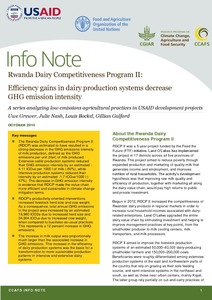Resumen de los datos del sondeo de sistemas y prácticas de manejo de los recursos agrícolas : Comunidades con sistemas de producción de cultivos anuales con tracción animal, Honduras: Reporte interno
Review of CGIAR Research Programs Governance and Management: Final Report
The Review of CGIAR Research Program Governance and Management was requested by the CGIAR Consortium and
approved by the Fund Council in November 2012. The Independent Evaluation Arrangement (IEA) is responsible for the review, which was carried out between June 2013 and January 2014. At the time the review was initiated, Consortium Research Programs (CRP) governance and management structures were in place or approved for each CRP. This enabled
Review of climate service needs and opportunities in Rwanda
Rwanda’s variable and changing climate is an increasingly serious challenge to the country’s
agricultural sector and farming population. Climate information services are emerging as a
means to support farmers to manage risk and provide an opportunity to build the resilience of
agriculture to climate at all time scales. Climate services include historical, monitored and
forecast information, and value-added information products such pest and disease risk
warnings, crop yield forecasts, or management advisories. The new Rwanda Climate Services
Runoff and sediment monitoring in an agricultural watershed in the Ethiopian Highlands
Land degradation due to soil erosion is a major issue in the Ethiopian Highlands. Deforestation leads to ongoing gully erosion during the rainy season (June to September) and thus the hydrology of a watershed changes as dense gully networks cause direct drainage of rain water. To better understand watershed scale gully processes in the Ethiopian Highlands, three gauging stations were installed in the 56 km2 large Gumara-Maksegnit catchment in the northern Amhara region, to monitor discharge and sediment load in the gullies during rainy season.
Rwanda Dairy Competitiveness Program II: Efficiency gains in dairy production systems decrease GHG emission intensity
? The Rwanda Dairy Competitiveness Program II
(RDCP) was estimated to have resulted in a
strong decrease in the GHG emissions intensity
of milk production, defined as the GHG
emissions per unit (liter) of milk produced.
Extensive cattle production systems reduced
their GHG emission intensity by an estimated -
4.11 tCO2e per 1000 l of milk (-60%), while
intensive production systems reduced their
intensity by an estimated -1.7 tCO2e/1000 l (-
47%). The decrease in GHG emission intensity
Scaling point and plot measurements of greenhouse gas fluxes, balances, and intensities to whole farms and landscapes
Measurements of nutrient stocks and greenhouse gas (GHG) fluxes are typically collected at very local scales (<1 to 30 m2) and then extrapolated to estimate impacts at larger spatial extents (farms, landscapes, or even countries). Translating point measurements to higher levels of aggregation is called scaling. Scaling fundamentally involves conversion of data through integration or interpolation and/or simplifying or nesting models. Model and data manipulation techniques to scale estimates are referred to as scaling methods.
Sediment trap efficiency of paddy fields at the watershed scale in a mountainous catchment in northwest Vietnam
Composite agricultural systems with permanent maize cultivation in the uplands and irrigated rice in the valleys are very common in mountainous southeast Asia. The soil loss and fertility decline of the upland fields is well documented, but little is known about reallocation of these sediments within the landscape. In this study, a turbidity-based linear mixed model was used to quantify sediment inputs, from surface reservoir irrigation water and from direct overland flow, into a paddy area of 13 ha. Simultaneously, the sediment load exported from the rice fields was determined.
Scaling Up Climate Services for Farmers in Africa and South Asia: Workshop Report
This report summarizes the proceedings of the workshop “Scaling Up Climate
Services for Farmers in Africa and South Asia,” held in Saly, Senegal on December
10-12, 2012. The workshop brought together more than 100 experts from 30 countries
and roughly 50 institutions to grapple with the challenge of supporting vulnerable
farming communities through the production, communication, delivery and evaluation
of effective agrometeorological information and advisory services; and to identify
practical actions to address those challenges at scale.
Seed systems of rice and finger millet in Nepal, between formality and informality
In Nepal, more than 90% of cereal seed flows from informal systems and there are regions and groups of farmers that are not connected at all to any seed networks with external seed supply. Nepal's agricultural policies and formal institutions are promoting the development of the formal seed system. However, knowledge gaps exist on the opportunities and challenges for smallholder farmers when formal seed systems are becoming accessible.
Scaling up climate services for farmers: Mission Possible. Learning from good practice in Africa and South Asia
This report presents lessons learned from 18 case studies across Africa and South Asia that have developed and delivered weather and climate information and related advisory services for smallholder farmers. The case studies and resulting lessons provide insights on what will be needed to build effective national systems for the production, delivery, communication and evaluation of operational climate services for smallholder farmers across the developing world.
Scaling up index insurance for smallholder farmers: Recent evidence and insights
This report explores evidence and insights from five case studies that have made significant recent progress in addressing the challenge of insuring poor smallholder farmers and pastoralists in the developing world. In India, national index insurance programmes have reached over 30 million farmers through a mandatory link with agricultural credit and strong government support. In East Africa (Kenya, Rwanda and Tanzania), the Agriculture and Climate Risk Enterprise (ACRE) has recently scaled to reach nearly 200,000 farmers, bundling index insurance with agricultural credit and farm inputs.












